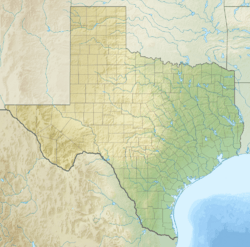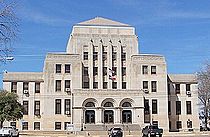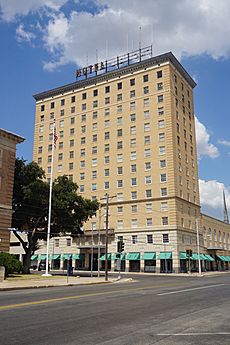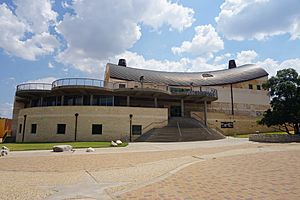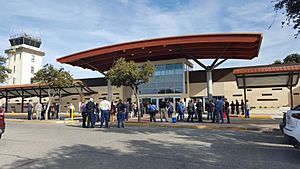San Angelo, Texas facts for kids
Quick facts for kids
San Angelo
|
||
|---|---|---|
|
City
|
||

San Angelo City Hall
|
||
|
||
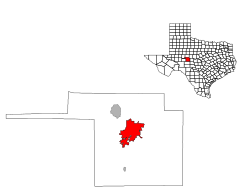
Location in the state of Texas
|
||
| Country | ||
| State | ||
| County | Tom Green | |
| Government | ||
| • Type | Council-manager | |
| Area | ||
| • City | 61.92 sq mi (160.38 km2) | |
| • Land | 59.64 sq mi (154.46 km2) | |
| • Water | 2.28 sq mi (5.91 km2) | |
| Elevation | 1,844 ft (562 m) | |
| Population
(2020)
|
||
| • City | 99,893 | |
| • Density | 1,613.26/sq mi (622.852/km2) | |
| • Metro | 121,516 | |
| • Demonym | San Angeloan | |
| Time zone | UTC−6 (CST) | |
| • Summer (DST) | UTC−5 (CDT) | |
| ZIP codes |
76901-09
|
|
| Area code(s) | 325 | |
| FIPS code | 48-64472 | |
| GNIS feature ID | 1375953 | |
| Website | The City of San Angelo, Texas | |
San Angelo is a city in Tom Green County, Texas, United States. It is located in the Concho Valley area of West Texas. In 2020, San Angelo had a population of 99,893 people. It is the main city of the San Angelo metropolitan area, which has a population of 121,516.
San Angelo is home to Angelo State University, the historic Fort Concho, and Goodfellow Air Force Base. It is also the center of the Roman Catholic Diocese of San Angelo.
Contents
History of San Angelo
Before Europeans arrived, the area of San Angelo was home to the Jumano people. Indigenous groups had lived here for over a thousand years.
In 1632, Spanish friars started a short-lived mission in the area for the local Indians. Later, in the 1800s, the region was claimed by Spain, Mexico, the Republic of Texas, and finally the United States in 1846.
Founding of the City
The city of San Angelo began in 1867. The United States built Fort Concho to protect the frontier. This fort was home to cavalry, infantry, and the famous Black Cavalry, known as Buffalo Soldiers.
A settler named Bartholomew J. DeWitt started a village outside the fort. He named it Santa Angela after his wife, Carolina Angela. The name later changed to San Angela, and then to San Angelo in 1883. This change happened because the United States Postal Service said "San Angela" was not correct in Spanish. The town quickly became a trading center for farmers and settlers.
Growth and Development
San Angelo grew fast in the 1880s because railroads arrived. It became a key transportation hub for the region. The Santa Fe Railroad came in 1888, and the Kansas City, Mexico and Orient Railway in 1909.
In the early 1900s, many people with tuberculosis (TB) moved to San Angelo. Doctors at the time suggested rest in dry, warm places for treatment.
In 1928, the city started San Angelo College. This college grew into Angelo State University. During World War II, the military returned with Goodfellow Air Force Base, which trained pilots. San Angelo also grew a lot during the oil boom in the 1900s, becoming a center for the oil and gas industry.
In 1955, the San Angelo Independent School District was one of the first in Texas to allow all students to attend together, without being separated by race.
Geography and Climate
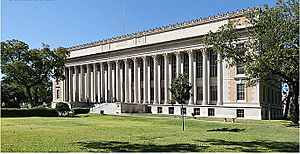
San Angelo is located at 31°26′34″N 100°27′1″W / 31.44278°N 100.45028°W. The city covers about 58.2 square miles (150.9 km²). Most of this is land, with about 2.3 square miles (6.1 km²) being water.
The city is on the edge of the Edwards Plateau and the Chihuahuan Desert. It sits where the North and South Concho Rivers meet. San Angelo has three lakes: Twin Buttes Reservoir, O.C. Fisher Reservoir, and Lake Nasworthy. The city is about 225 miles (362 km) west of Austin.
Weather in San Angelo
San Angelo has a semi-dry climate. This means it gets hot, but not a lot of rain. Temperatures can reach 100°F (38°C) about 18 times a year on average. In 2011, it was 100°F or hotter for 100 days! The average year has 50 days with temperatures below freezing. Snow and sleet happen only a few times a year. San Angelo gets about 251 sunny days each year. The average temperature is 65.4°F (18.6°C). The city gets about 21.25 inches (540 mm) of rain each year.
| Climate data for San Angelo, Texas | |||||||||||||
|---|---|---|---|---|---|---|---|---|---|---|---|---|---|
| Month | Jan | Feb | Mar | Apr | May | Jun | Jul | Aug | Sep | Oct | Nov | Dec | Year |
| Record high °F (°C) | 91 (33) |
97 (36) |
98 (37) |
107 (42) |
110 (43) |
110 (43) |
111 (44) |
111 (44) |
107 (42) |
102 (39) |
93 (34) |
91 (33) |
111 (44) |
| Mean daily maximum °F (°C) | 59.5 (15.3) |
63.5 (17.5) |
71.1 (21.7) |
80.1 (26.7) |
87.2 (30.7) |
92.1 (33.4) |
95.1 (35.1) |
94.7 (34.8) |
87.8 (31.0) |
78.8 (26.0) |
68.3 (20.2) |
59.9 (15.5) |
78.2 (25.7) |
| Mean daily minimum °F (°C) | 33.3 (0.7) |
37.0 (2.8) |
44.4 (6.9) |
51.9 (11.1) |
61.8 (16.6) |
68.8 (20.4) |
71.2 (21.8) |
70.7 (21.5) |
63.5 (17.5) |
53.6 (12.0) |
42.3 (5.7) |
33.6 (0.9) |
52.7 (11.5) |
| Record low °F (°C) | 1 (−17) |
−1 (−18) |
8 (−13) |
23 (−5) |
35 (2) |
40 (4) |
54 (12) |
45 (7) |
35 (2) |
19 (−7) |
12 (−11) |
−4 (−20) |
−4 (−20) |
| Average precipitation inches (mm) | 0.93 (24) |
1.35 (34) |
1.50 (38) |
1.42 (36) |
2.82 (72) |
2.59 (66) |
1.20 (30) |
2.26 (57) |
2.46 (62) |
2.73 (69) |
1.14 (29) |
0.85 (22) |
21.25 (540) |
| Source: National Weather Service | |||||||||||||
Population of San Angelo
| Historical population | |||
|---|---|---|---|
| Census | Pop. | %± | |
| 1890 | 2,615 | — | |
| 1910 | 10,321 | — | |
| 1920 | 10,050 | −2.6% | |
| 1930 | 25,308 | 151.8% | |
| 1940 | 25,802 | 2.0% | |
| 1950 | 52,093 | 101.9% | |
| 1960 | 58,815 | 12.9% | |
| 1970 | 63,884 | 8.6% | |
| 1980 | 73,240 | 14.6% | |
| 1990 | 84,462 | 15.3% | |
| 2000 | 88,439 | 4.7% | |
| 2010 | 93,200 | 5.4% | |
| 2020 | 99,893 | 7.2% | |
| 2021 (est.) | 99,667 | 6.9% | |
| U.S. Census Bureau Texas Almanac | |||
As of the 2020 United States census, there were 99,893 people living in San Angelo. There were 36,843 households and 23,026 families.
Racial Makeup
| Race | Number | Percentage |
|---|---|---|
| White (NH) | 48,114 | 48.17% |
| Black or African American (NH) | 3,846 | 3.85% |
| Native American or Alaska Native (NH) | 293 | 0.29% |
| Asian (NH) | 1,639 | 1.64% |
| Pacific Islander (NH) | 135 | 0.14% |
| Some other race (NH) | 314 | 0.31% |
| Mixed/multiracial (NH) | 3,243 | 3.25% |
| Hispanic or Latino | 42,309 | 42.35% |
| Total | 99,893 |
In 2020, about 48.17% of the people were White (not Hispanic). About 3.85% were Black or African American. People of Hispanic or Latino background made up 42.35% of the population.
Economy and Jobs
San Angelo is often called one of the best small cities for business and jobs. In 2013, Forbes magazine ranked it fourth in the nation for "Best Small Cities For Jobs." In 2009, CNN Money said it was one of the best cities to start a small business.
San Angelo has a varied economy. Many companies that support the oil industry are based here. The farming industry is also very strong. The Producer's Livestock Auction is the largest in the nation for sheep and lambs. It is also one of the top five for cattle auctions. Thousands of people work in meat processing and other farming-related jobs.
The telecommunications industry is a big employer. Companies like Sitel, Frontier Communications, and Blue Cross all employ many people. San Angelo is also a medical center for west-central Texas. Shannon Medical Center employs over 3,000 people. Many manufacturing companies are still in the city, including Ethicon, a part of Johnson & Johnson.
Large employers in the city include Shannon Medical Center, Angelo State University, and Goodfellow Air Force Base. The Air Force Base is the largest employer, supporting over 24,000 people in San Angelo.
The Sunset Mall is the main shopping mall in the area. It opened in 1979.
Arts and Culture
San Angelo Museum of Fine Arts
The San Angelo Museum of Fine Arts opened in 1999. It is located downtown by the Concho River. The museum is built with local limestone and Texas mesquite wood. It welcomes over 85,000 visitors each year and hosts the National Ceramic Competition.
San Angelo Performing Arts Center
The San Angelo Performing Arts Center (PAC) offers many live shows. It uses two historic buildings: the 1,350-seat Murphey Auditorium (built in 1928) and the Stephens Performing Arts Center. The Stephens Center has the 300-seat Brooks and Bates Theater, ballet studios, and other spaces. Since 2017, the PAC has hosted over 100 performances every year.
Art Galleries and Public Art
Downtown San Angelo has several art galleries. Raw 1899 is a wine bar that often shows art. Art in Uncommon Places has an outdoor Pop Art Museum and keeps Paintbrush Alley colorful. You can take a free trolley to visit these places.
San Angelo Symphony
The San Angelo Symphony started in 1949. It performs five concerts each year. These concerts are held in the Murphey Performance Hall and at Angelo State's Junell Center.
Angelo Civic Theatre
Angelo Civic Theatre is the oldest community theater in Texas. It was founded on November 21, 1885. The theater has been through tough times, but it kept putting on shows. In 1980, it bought the historic 230-seat Parkway Theater. Angelo Civic Theatre still performs six plays each year for the community.
Ballet San Angelo
Ballet San Angelo was founded in 1983. Its first goal was to put on an annual production of The Nutcracker. Now, it offers a full season of ballet shows, including a choreography performance and a Children's Ballet. Ballet San Angelo also teaches ballet, has a fitness program, and helps the community.
Plays at Angelo State University
Angelo State University puts on six plays each year that are open to the public. These shows use the only active modular theater in the United States. The university also has many concerts, recitals, and art displays in its Art Gallery. Everyone is welcome to attend.
Parks and Recreation
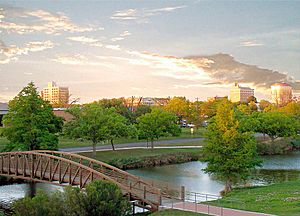
City Parks
The San Angelo City Park system began in 1903. The city has 32 parks with over 375 acres (1.5 km²) of developed land. The parks department takes care of a 33-acre (13 ha) municipal golf course, 25 playgrounds, and 25 sports fields.
The most special parts of the park system are the parks along the Concho River. These parks stretch for 10 miles (16 km) through downtown. They have plazas, public art, and water features. The city is also home to the International Water Lily Collection, which has over 300 types of water lilies. This is one of the largest collections in the world.
The city also has several parks on Lake Nasworthy. This is one of three lakes near the city, along with Twin Buttes Reservoir and O.C. Fisher Reservoir.
San Angelo State Park
The 7,677-acre (3,107 ha) San Angelo State Park is on the shores of the O.C. Fisher Reservoir. It is managed by the Texas Parks and Wildlife Department. You can go camping, picnicking, swimming, hiking, mountain biking, and horseback riding on over 50 miles (80 km) of trails. The park is home to the official State of Texas Longhorn herd.
Fort Concho
Historic Fort Concho is a National Historic Landmark. The city of San Angelo takes care of it. The United States Army founded the fort in 1867 to protect settlers and trade routes. The restored fort has several museums and is open to visitors. Fort Concho is one of nine forts along the Texas Forts Trail.
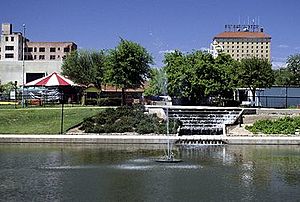
San Angelo Stock Show and Rodeo
The San Angelo Stock Show and Rodeo happens every year. It started in 1932, making it one of the oldest rodeos in the world. It is well-known in the rodeo world, attracting top contestants. It is one of the top 10 rodeos in the nation for prize money. The event also includes a parade, a carnival, and concerts.
Education in San Angelo
Colleges and Universities

San Angelo is home to Angelo State University. It was founded in 1928 and has about 10,000 students. Students come from all over Texas, 40 states, and 24 countries. It is known as one of the best regional universities.
Angelo State offers almost 100 different undergraduate programs and 23 graduate programs. It has six colleges: Business, Education, Liberal and Fine Arts, Nursing and Allied Health, Sciences, and Graduate Studies. Since 2007, it has been part of the Texas Tech University System.
San Angelo also has a branch of Howard College. This two-year school helps students get ready to transfer to a four-year university. It also offers programs in technical fields that lead to certificates or associate degrees.
A branch of Park University is located at Goodfellow Air Force Base. This campus has been providing higher education since 1989.
Public Schools
Most of San Angelo is part of the San Angelo Independent School District. Smaller parts are in the Wall Independent School District, Grape Creek Independent School District, and Veribest Independent School District. The two main high schools are Central and Lake View. There are also three middle schools and 21 elementary schools within the city.
Private and Alternative Schools
There are eight private schools in San Angelo that go up to 12th grade. These include Ambleside School of San Angelo, San Angelo Christian Academy, Angelo Catholic School, Cornerstone Christian School, Gateway Christian Academy, Trinity Lutheran School, Potter's Hand Christian School, and Texas Leadership Charter Academy (a charter school).
Media
Newspapers
- San Angelo Standard-Times (print)
- GoSanAngelo (digital)
Television
| Channel |
Call letters |
Network |
|---|---|---|
| 3 | KSAN | NBC |
| 8 | KLST | CBS |
| 19 | KIDY | FOX |
| 22 | KTXE-LD | ABC |
| 41 | KEUS-LP | Univision |
Radio
AM stations
| Frequency |
Call letters |
Format |
|---|---|---|
| 960 | KGKL (AM) | News/Talk |
| 1260 | KKSA | News/Talk |
| 1400 | KRUN (AM) | Traditional Country |
FM stations
| Frequency |
Call letters |
Format |
|---|---|---|
| 88.5 | KLRW | Christian Contemporary |
| 89.3 | KNAR | Christian Contemporary |
| 90.1 | KNCH | Public Radio |
| 90.5 | K213EW | Christian Contemporary |
| 90.9 | KLTP | Christian Contemporary |
| 91.5 | KPDE | Religious |
| 91.9 | KMEO | Religious |
| 92.9 | KDCD | Country |
| 93.9 | KSAO | Christian Contemporary |
| 94.7 | KIXY | Top 40 |
| 95.5 | KMLS | Classic Rock |
| 96.5 | KNRX | Active Rock |
| 97.1 | KCSA-LP | Variety |
| 97.5 | KGKL-FM | Country |
| 98.7 | KELI-FM | Top 40 CHR |
| 99.5 | KQTC | Tejano |
| 100.1 | KCLL | Classic Hits |
| 101.9 | KWFR | Classic Rock |
| 103.1 | KKCN | Texas Country |
| 104.5 | KPTJ | Spanish |
| 106.1 | KMDX | Urban |
| 107.5 | KSJT-FM | Spanish |
Transportation
San Angelo is served by the San Angelo Regional Airport. It has daily flights to the Dallas Fort Worth International Airport. Bus service is available through Greyhound to other cities in Texas and across the country.
Within the city, public transportation is provided by the Concho Valley Transit District. It has five bus routes that run Monday through Saturday. Taxi services are also available.
The BNSF Railway serves the town. The Texas Pacifico also uses a rail line owned by the TxDOT.
Images for kids
-
Texan Hall on Angelo State University Campus
See also
 In Spanish: San Ángelo para niños
In Spanish: San Ángelo para niños



